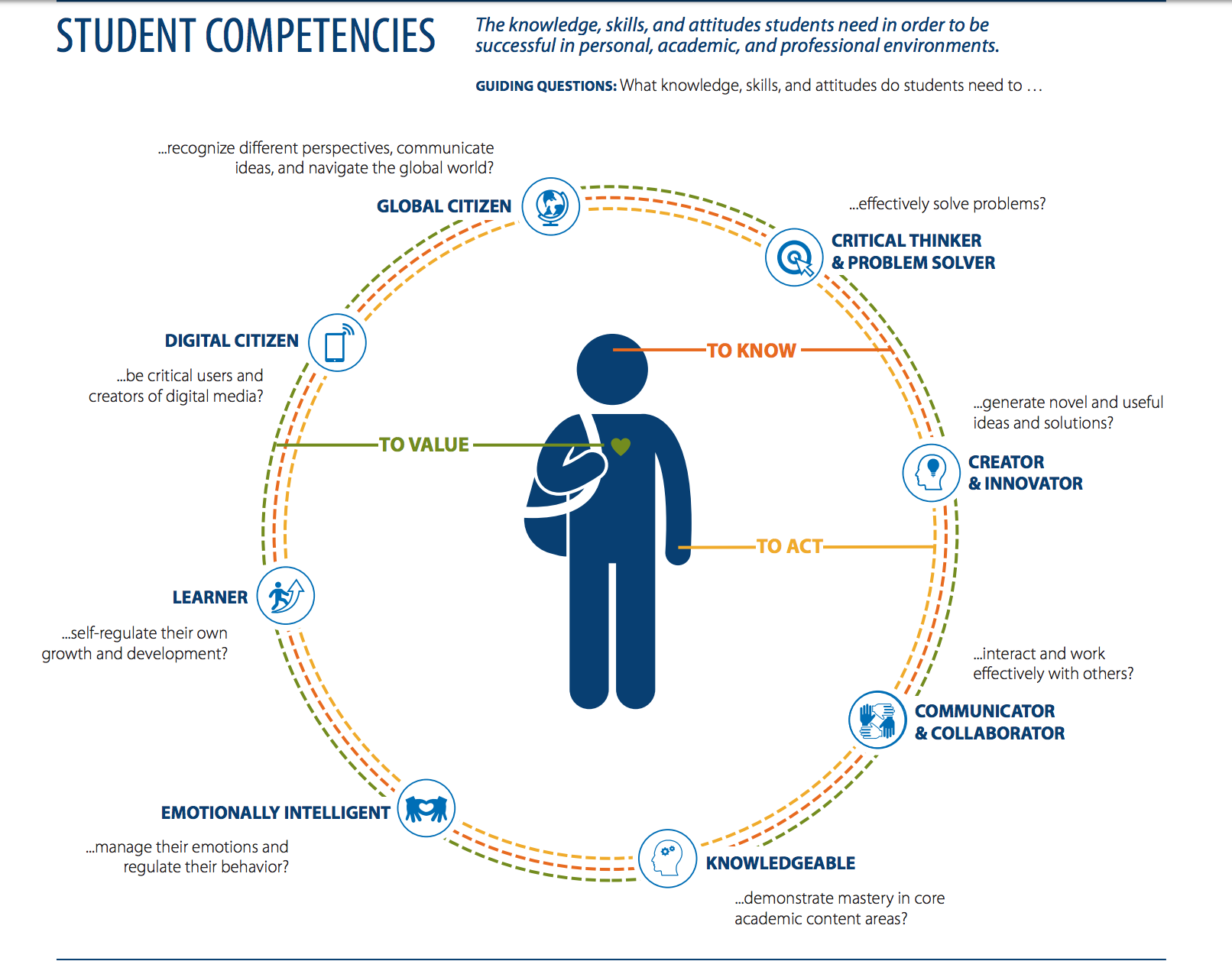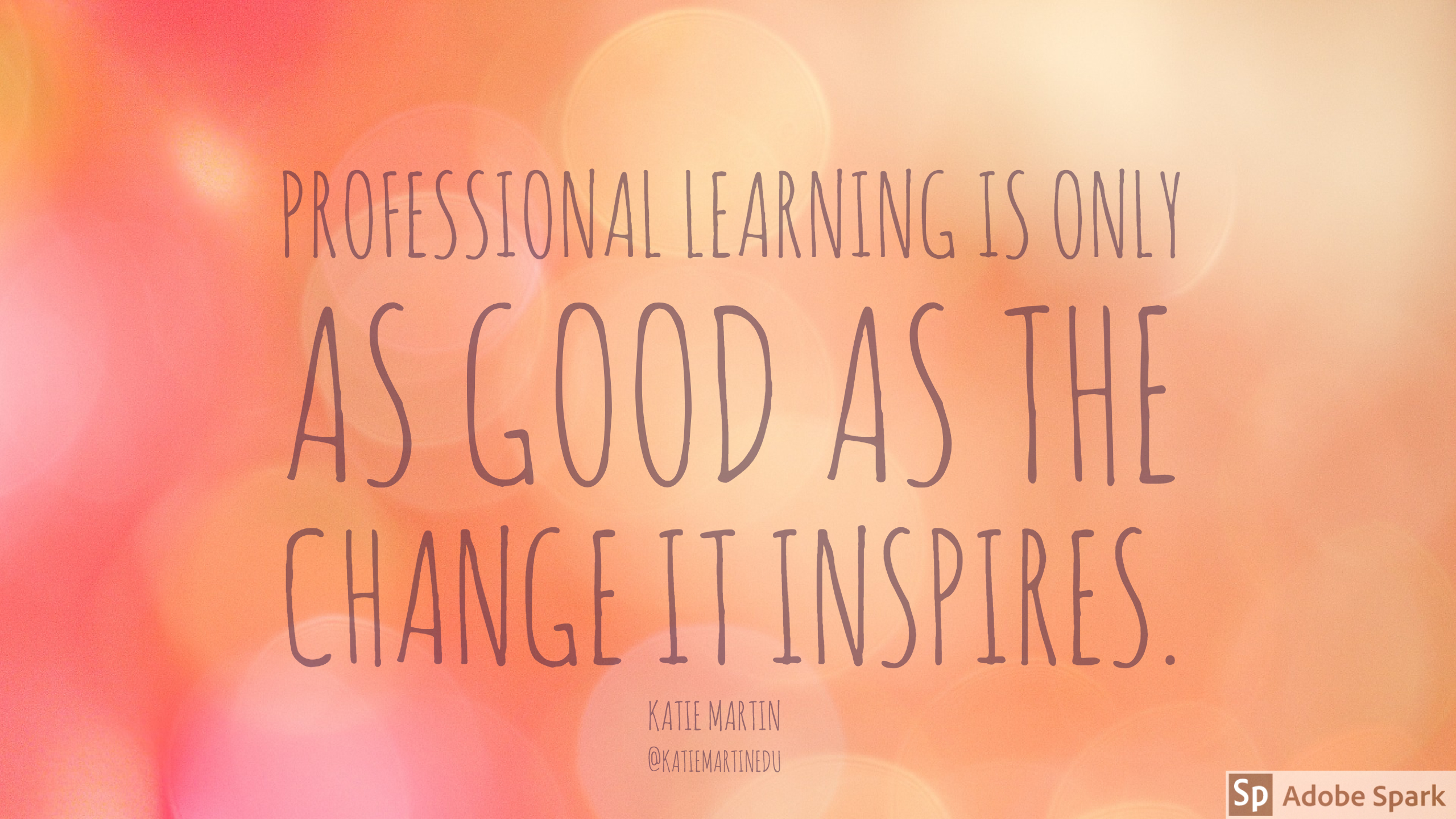I shared this article recently, 5 Reasons Professional Development is NOT Transforming Learning. Not surprisingly, it resonated with many people.
So, if your professional development isn’t working.
Try this…
Cultivate a Shared Vision
Creating a graduate profile with clear outcomes that the community values is a great way to anchor conversations about teaching and learning in desired outcomes for learners. When a learning community is clear on the purpose, the conversations about strategies, resources, and expectations are grounded in what and how to achieve desired outcomes for students—not program mandates that may or may not be best for the learners in your unique context. When I was working at the University of San Diego, We developed a model to help districts think about the desired competencies that they seek to develop in their students. It’s not meant to be adopted as is, but to inspire conversations, based in research, about the desired student outcomes in your community.

Image from USD IEE, 2017
Ensure Learning is a Process, Not an Event
A culture of learning must begin with a safe space for teachers to open their doors, share their practices, receive feedback, and relentlessly pursue opportunities to more effectively develop the knowledge and skills to create the desired learning environments. Instead of using staff meetings to convey information, make time for teachers to connect and share what they are learning and risks they are taking and what the impact of that is on their students. Shared learning and meaningful connection boosts morale and creates a culture of learning.
I shared this recently in a post, To Inspire Change, Make Learning Public:
If you have a great idea but are afraid to try it because you aren’t sure if it’s going to work or you are afraid of what others will say, the status quo will prevail. When innovative practices are celebrated and shared, great learning can spread through schools and the world. If we only tell the stories of the good or gloss over the challenges, we miss the power of the learning process instead of sharing the hurdles that are part of learning. The culture of learning and risk-taking can make great ideas and practices spread through schools and communities like wildfire or keep it hidden behind closed doors.
Focus on The “Right” Student Outcomes
For some, accountability has a bad connotation because of the overemphasis on standardized test scores. So don’t tune out. When I speak of accountability, I am talking about a much broader focus on student outcomes than a single standardized test. Teacher efficacy is defined as the belief in your ability to impact student outcomes. When teachers know they have an impact on the learners they serve, they are more efficacious and willing to try new things.
If you have a shared vision and look for evidence of achieving the desired outcomes in your vision it can help ensure everyone is focusing on creating experiences to in service of that vision. But if you never look at student work, observe learning in process, and analyze the impact on those desired skills, how will we build a shared understanding of what it takes to get there? To improve student achievement, we must focus the bulk of our energy on the collective analysis of evidence of student learning rather than the inspection of teaching. If we dedicate time and resources to collaborate and design better learning experiences for students, we need to hold one another accountable to and support each other as we seek to improve.
Connect with Other Educators
Overwhelmingly, teachers prefer to learn from and with their peers, and we all benefit from regular collaborative learning opportunities with others. Put effective systems in place for teachers to connect and collaborate during the work day so they can learn new strategies and increase their effectiveness and efficacy through the collective knowledge and support of the learning community. Teachers regularly suggest the following collaborative structures be embedded in the work day to facilitate their growth and development:
- Communities of inquiry to find and solve problems together
- Differentiated opportunities to choose based on comfort, skills, and context
- Job-alike teams to design, reflect, and examine evidence of learning experiences
Connecting with other educators in your school, district, or globally, will expose you to new ideas or push thinking about better ways of doing things. It is easy think that the way you have been doing it is the only or best way when you aren’t seeing other models. There are so many resources and opportunities available for educators to connect with and learn from one another. By sharing examples using a school hashtag or at a staff meeting make learning and growth public and a shared process. To continue learning and developing your practice, it is important for teachers to get out of their classroom, both physically and virtually, to leverage the collective genius of the many educators across the globe.
Do Something
Professional learning is only as good as the change it inspires. With that in mind, it is important to start small with actionable steps that are about growth, not perfection. When you are in charge of designing professional learning days, like teaching in the classroom, there is always “so much to cover” in a short amount of time. It is tempting to cram it all in instead of modeling the desired learning and teaching. When in reality it is the personal and action-oriented professional learning experiences that shift our practices to the desired learning and teaching.
To shift practices, the best experiences:
- Build on what individuals know and can do
- Empower learners to explore questions or challenges that directly impact them and their unique context
- Create opportunities to get your hands dirty and do something
- Engage in ongoing opportunities to reflect, refine, and improve in a community of learners
Empowering teachers to design, implement, reflect, and revise can allow for ideas to turn into better practice. When there are clear goals and action-oriented cycles of learning to put ideas into practice or structures to share learning with peers, it inspires accountability and encourages change in practice.
Shifting Practice
Too often what we know but fail to change about traditional professional development– telling teachers things that rarely get translated to practice. To transform learning in our classrooms, we need to focus professional learning on changing habits (or behaviors), and the need for ongoing practice and support, rather than isolated instances of knowledge acquisition that continue to add on more programs rather than define, model, and integrate desired practices.



0 Comments